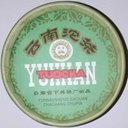Tea: Xiaguan Te Ji Raw Pu-Erh Tuo
A Raw (Sheng) Pu-erh from Xiaguan Tea Factory
| Brand: | Xiaguan Tea Factory |
| Style: | Raw (Sheng) Pu-erh |
| Region: | Yunnan, China |
| Caffeine: | Caffeinated |
| Loose? | Compressed |
| # Ratings: | 1 View All |
Reviewer: Difflugia

✓ 170 teas reviewed
✓ 1 of Raw (Sheng) Pu-erh
✓ 2 of Pu-erh Tea
✓ 1 of Xiaguan Tea Factory
✓ 6 from Yunnan, China
✓ 28 from China
Review of Xiaguan Te Ji Raw Pu-Erh Tuo
July 14th, 2019
| Aroma | Flavor | Value | Total |
| 7 of 10 | 4 of 5 | 4 of 5 | 75 of 100 |
| Very Good | Good | Good Value |
SECOND UPDATE: I'm pretty sure now that this tuo is counterfeit and not really from the Xiaguan factory. I'd been drinking leaves from the surface, which were good, but just broke through to a second layer of chopped up leaves and twigs. I'm rather surprised at the amount of effort that went into counterfeiting a tea that isn't particularly expensive to start with.
This is definitely a young sheng (raw) pu-erh and that's really about all I know about this tea. I'd yet to try sheng pu-erh (young or old), so when I saw it in an Asian, mom-and-pop grocery for $4, I had to try it. There's no date anywhere on the package, so I've no idea what year it's from, but it can't be very old because the tea is still really green and it was too cheap to have been aged.
So far, all of the pu-erh teas that I've tried have been shou pu-erh, so I really didn't know what to expect. The unwrapped tuo smells faintly grassy and has a hint of seaweed like Japanese green teas.
The compacted tea was denser than I expected. I used a butter knife to try to flake pieces off, but it really took some force to break pieces off. I weighed the tea as I broke it off (10 grams for a 32 ounce pot) and it didn't look like enough, but it expanded a lot when brewed. After breaking the pieces off, the pieces and the broken surface of the tuo smelled strongly of grass, seaweed and alfalfa. I treated it as green tea and brewed it western-style with 180° water for four minutes.
The brewed tea reminds me strongly of inexpensive gunpowder greens. It's spicy, smoky, and vegetal. There are notes of raw broccoli and spinach. Some medicinal notes while the tea was hot seemed to disappear as the tea cooled. I suspect those may be more volatile flavors that were preseved by compressing the tea so tightly that are normally lost in loose styles. It's pleasantly bitter, but not as bitter as I'd expected from online descriptions of young sheng pu-erh. It's novel and flavorful as a green tea, but I can understand how aging might improve it.
I brewed the tea a second time at 190° for five minutes. The tea has almost as much color this time as the first. It's not as pungent as the original brewing, but still has enough aroma and flavor to be pleasant. Most of the spiciness and bitterness are gone, but it's still grassy and refreshing.
The tuo is 100g of tea (I weighed it to be 98g), so it was a little over $1 per ounce. Judged as a green tea, I'd say that it's on par with, or a bit better than other teas in that price range. Since I'm not looking to age tea myself, I probably won't buy another one.
UPDATE: I'm really enjoying this tea. As I've progressed through the tuo, I've improved my technique for breaking apart the tea and can now get decent-sized flakes with mostly whole leaves. I've also been trying with varying temperatures of water and have to say that I prefer hotter (boiling) water to steep the tea.
This tea is much more caffeinated than other teas. Also, multiple steeps keep delivering flavor as the tea hydrates. I'm on my fourth western-style, five-minute steep and the flavor is just starting to weaken. The first three were all more flavorful than the first steep of most green teas.
I bought two more tuos. Not because I intend to age them, but I expect to drink them sooner rather than later.
Add your own review
Comments:
| nature herbal life wrote: on May 29th, 2020 |
This is amazing tea. I like it


